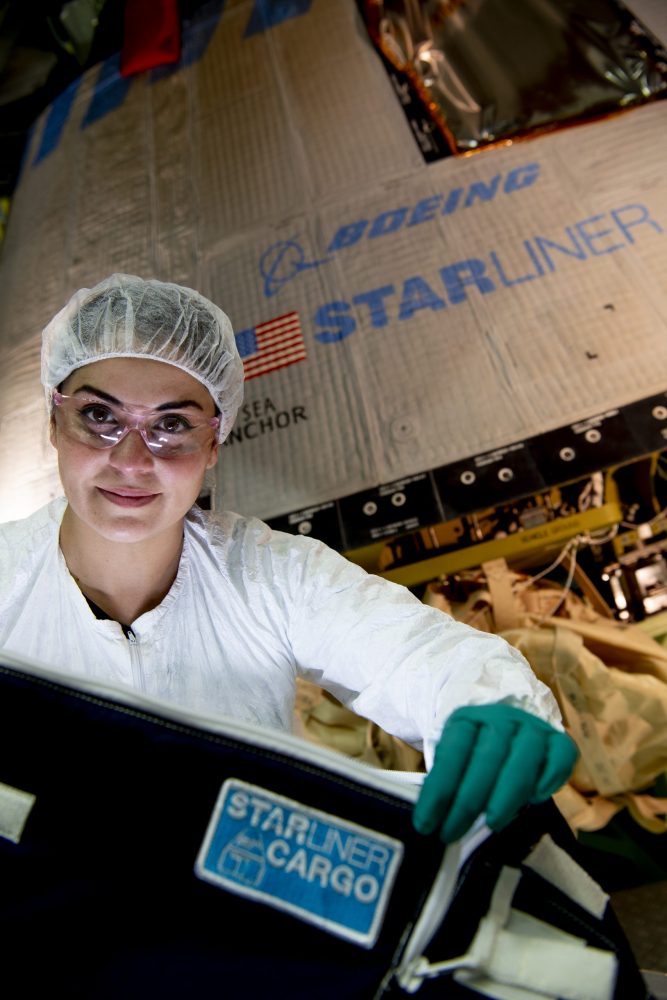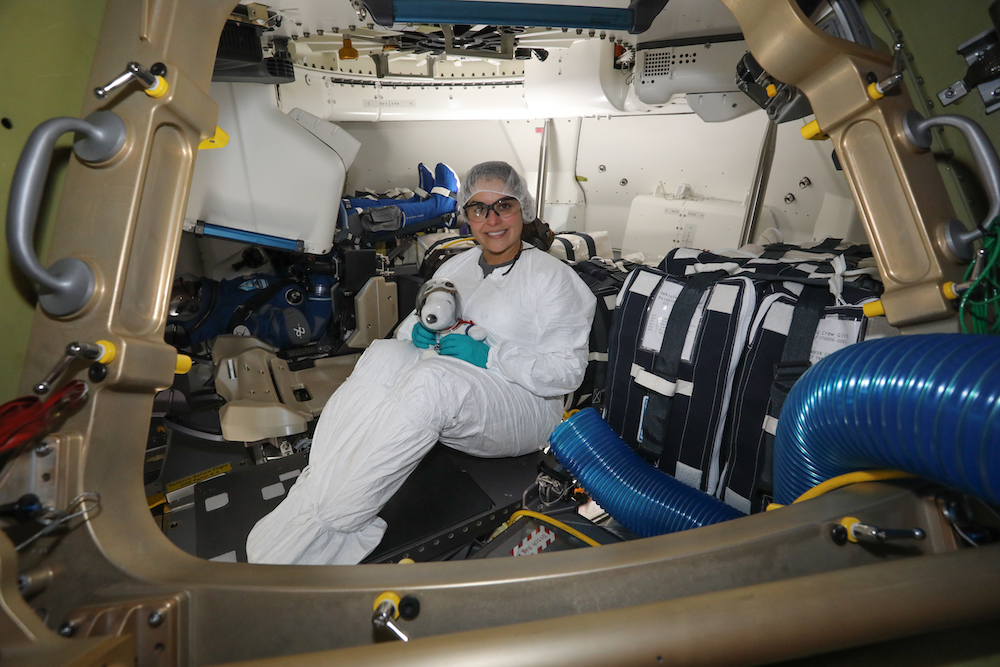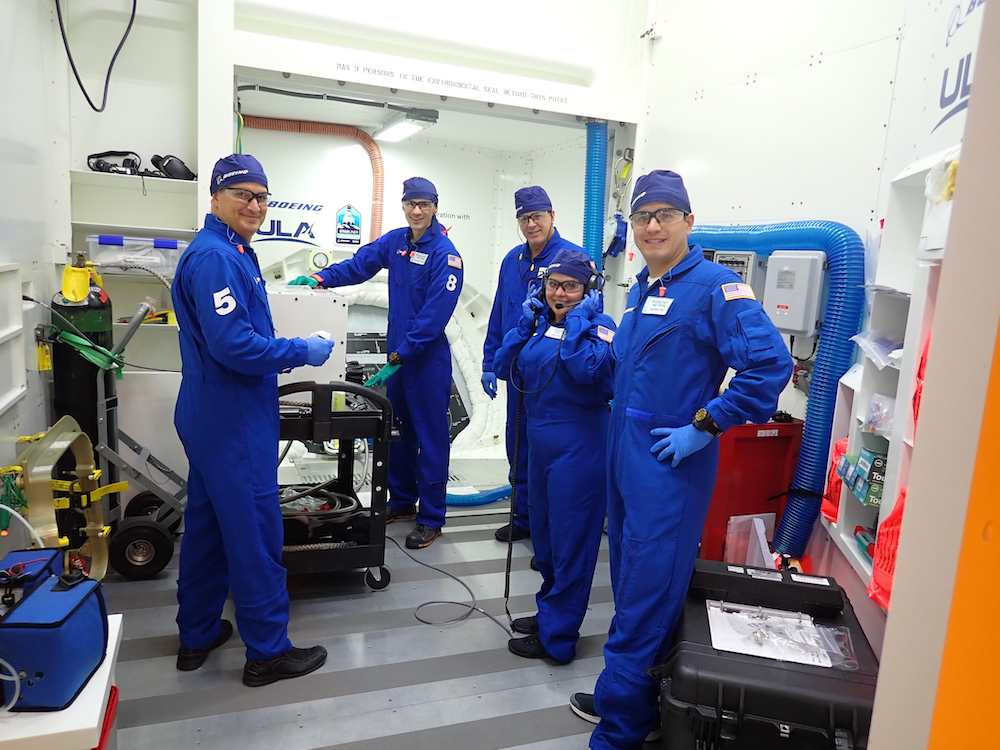When we think of rockets, most of us think of their exteriors; the massive sight of them towering over the buildings on the launch pad. But, just as a rocket’s exterior has to be designed to protect its passengers from the harsh exit and re-entry of the Earth’s atmosphere, the interior must be designed to, not only meet a variety of safety standards but also be efficient and comfortable for the crew. Melanie Weber, Subsystem Lead for Crew and Cargo Accommodations and Pad Team Lead with Boeing, is responsible for those design elements in the interior of the CST-100 Starliner, and she ensures that there is a lot more to consider than many might think.
“There has been a lot of coordination between Chris Ferguson and me about where to place Velcro,” laughed Melanie.
Velcro is important for crew efficiency, and “you can’t put [too much Velcro] next to each other, because it could propagate a fire.”
Weber joined the program about eight years ago as part of a rotation program in Houston. “There was no design of [the Starliner’s] interior – it was just kind of a shell of a vehicle with basic concepts and capabilities.

“When they brought me on, they said, ‘you can work on whatever you want,’ she continued. “I said that I wanted to do the interior design of the vehicle, and they said, ‘Perfect.’”
Weber had to start first by laying out areas for the crew. She had to determine where the seats would be, where the cargo would be placed … she also had to help design the physical barrier between the crew and electrical wiring. And of course, there were other considerations to be made like, where would the control panel be? And, where will the air conditioning go?
“I knew that I was about to get into, what would be, one of the hardest things I would have to do in my life. It is the most challenging thing I’ve done in my entire life.”
Weber explained that she has to also design the interior in such a way that the astronauts can perform their daily functions.

“I want it to be intuitive,” she said. “I want them to go to their seat and automatically know. If they pause for a minute, I did something wrong.”
“Everything has to have a purpose,” she continued. “So many considerations go into designing a human spacecraft. It all goes back to human psychology.”
One of the biggest challenges her team faced was the design of the seats. The astronauts from the Gemini and Apollo eras were all relatively the same size, so it was more doable to create a “one size fits all” seat. Today’s engineers have to accommodate a female in the 5th percentile, up to a male in the 95th percentile, and the seats need to be functional and reusable. It is a challenge, but Boeing found the solution.
Weber explained that the seat is modifiable. To make the seat custom for each astronaut, the engineers scan the astronauts’ backs, and build a 3D-printed insert which is placed into the structure of the seat. This insert is the only part of the seat that is changed between each mission, ensuring comfort for the crew, and affordability for Boeing.

“There is a patent on this technology now, and we are very proud,” said Weber.
As part of this role, Weber is also responsible for packing the cargo for the crew, and while she joked that this job is for those who are very good at Tetris, she also has to think of crew efficiency when packing.
“I have to think about how the crew will open up the bag,” she said. “I have to consider, ‘how is it labeled?’ ‘Will the crew know the difference between one cable and the other?’” It falls upon her to ensure everything inside that Starliner is safe and efficient.
But Weber has another role with Boeing: Pad Team Lead. Her crew was the first to stand next to a fully loaded Atlas V and Centaur rocket.
She explained that her crew began at 2 a.m. the day of launch for the uncrewed orbital flight test. They had to do their checks to ensure the rocket was safe. The entire time, she was in communication with NASA and ULA, so if she were to happen upon something she didn’t like, she could communicate with them and let them know.
She did say that “Everything was way quieter than I expected it to be. Why? Because everything was going perfectly.”
Weber continued that the day of launch is emotional, as “it is more than just a spacecraft for us. It’s part of our lives. It’s an extension of ourselves.
“I know we’re supposed to have work-life balance, but most people here fail miserably on that,” she continued. “We’re human spaceflight – we love what we do.”
The CST-100 Starliner is an important and necessary step in human space exploration. And Weber and her team are just some of the incredible people ensuring its success.

Sara Santora
As a Space Coast native, Sara enjoys using her love of writing to speak directly to the community that raised her. She graduated from Florida State University with a B.A. in English, and has written for a variety of magazines; however, her love for publishing and writing developed as a young girl, when she received her first copy of Teen Vogue. When she isn't writing or at work, she is traveling around the state with friends, visiting coffee shops, going to live shows and brushing up on her photography skills. Follow her on Instagram or connect with her on LinkedIn.




